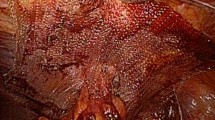Abstract
Introduction
The repair of parastomal hernias represents a surgical problem with high complication and failure rates. A basic principle is the necessity of mesh-based techniques. The study was performed to evaluate a laparoscopic approach, primarily based on the intraperitoneal on lay mesh technique.
Methods
Sixty-six patients with a symptomatic parastomal hernia were enrolled in the prospective study between November 1999 and February 2006. After complete adhesiolysis, the mesh was introduced to cover the fascial defect of the hernia and the original midline incision. In special cases, a two-mesh technique was used. First, an incised mesh was placed around the stoma sling. The second mesh was used to cover the abdominal wall with the first mesh; the stoma sling was placed between the two meshes for at least 5 cm.
Results
The two-mesh technique proved to be superior in terms of recurrence rate especially in cases with a lateral fascial defect.
Conclusions
The laparoscopic repair of parastomal hernias is a surgically challenging procedure with promising results when using the two-mesh technique. Therefore, two meshes should be used in all cases of parastomal hernias. Polyvinylidene fluoride was revealed to be the most suitable material for the sandwich repair in terms of possible ingrowth and infection resistance.

Similar content being viewed by others
References
Leslie D. The parastomal hernia. Surg Clin North Am 1984;64:407–15.
Pearl RK. Parastomal hernias. World J Surg 1989;13:569–72
Cheung MT. Complications of an abdominal stoma: an analysis of 322 stomas. Aust N Z J Surg 1995;65:808–11.
Bewes PC. Parastomal hernia. Ann R Coll Surg Engl 1997;79:154–5.
Kasperk R, Willis S, Klinge U, Schumpelick V. Update on incisional hernia. Parastomal hernia. Chirurg 2002;73:895–8
Rubin MS, Schoetz DJ Jr, Matthews JB. Parastomal hernia. Is stoma relocation superior to fascial repair? Arch Surg 1994;129:413–8
Cheung MT, Chia NH, Chiu WY. Surgical treatment of parastomal hernia complicating sigmoid colostomies. Dis Colon Rectum 2001;44:266–70.
Klinge U, Si ZY, Zheng H, Schumpelick V, Bhardwaj RS, Klosterhalfen B. Collagen I/III and matrix metalloproteinase’s (MMP) 1 and 13 in the fascia of patients with incisional hernias. J Invest Surg 2001;14:47–54.
Klinge U, Conze J, Krones CJ, Schumpelick V. Incisional hernia: open techniques. World J Surg 2005;29:1066–72
Stephenson BM, Phillips RK. Parastomal hernia: local resiting and mesh repair. Br J Surg 1995;82:1395–6.
Martin L, Foster G. Parastomal hernia. Ann R Coll Surg Engl 1996;78:81–4.
Morris-Stiff G, Hughes LE. The continuing challenge of parastomal hernia: failure of a novel polypropylene mesh repair. Ann R Coll Surg Engl 1998;80:184–7.
Tekkis PP, Kocher HM, Payne JG. Parastomal hernia repair: modified thorlakson technique, reinforced by polypropylene mesh. Dis Colon Rectum 1999;42:1505–8.
Kasperk R, Klinge U, Schumpelick V. The repair of large parastomal hernias using a midline approach and a prosthetic mesh in the sublay position. Am J Surg 2000;179:186–8.
Amin SN, Armitage NC, Abercrombie JF, Scholefield JH. Lateral repair of parastomal hernia. Ann R Coll Surg Engl 2001;83:206–8.
White TJ, Santos MC, Thompson JS. Factors affecting wound complications in repair of ventral hernias. Am Surg 1998;64:276–80.
Cassar K, Munro A. Surgical treatment of incisional hernia. Br J Surg 2002;89:534–45.
Le Blanc KA. Incisional hernia repair: laparoscopic techniques. World J Surg 2005;29:1073–9.
Sugarbaker PH. Peritoneal approach to prosthetic mesh repair of paraostomy hernias. Ann Surg 1985;201:344–6.
Stelzner S, Hellmich G, Ludwig K. Repair of paracolostomy hernias with a prosthetic mesh in the intraperitoneal onlay position: modified Sugarbaker technique. Dis Colon Rectum 2004;47:185–91.
LeBlanc KA, Bellanger DE. Laparoscopic repair of paraostomy hernias: early results. J Am Coll Surg 2002;194:232–9.
Le Blanc KA, Bellanger DE, Whitaker JM, Hausmann MG. Laparoscopic parastomal hernia repair. Hernia 2005;9:140–4.
Voitk A. Simple technique for laparoscopic paracolostomy hernia repair. Dis Colon Rectum 2000;43:1451–3
Kozlowski PM, Wang PC, Winfield HN. Laparoscopic repair of incisional and parastomal hernias after major genitourinary or abdominal surgery. J Endourol 2001;15:175–9.
Safadi B. Laparoscopic repair of parastomal hernias: early results. Surg Endosc 2004;18:676–80.
Klinge U, Klosterhalfen B, Öttinger AP, Junge K, Schumpelick V. PVDF as a new polymer for the construction of surgical meshes. Biomaterials 2002;23:3487–93
Israelsson LA. Preventing and treating parastomal hernia. World J Surg 2005;29:1086–9.
Gonzalez R, Fugate K, McClusky D, et al. Relationship between tissue ingrowth and mesh contraction. World J Surg 2005;29:1038–43.
Johnson EK, Hoyt CH, Dinsmore RC. Abdominal wall hernia repair: a long-term comparison of Sepramesh and Dualmesh in a rabbit hernia model. Am Surg 2004;70:657–61.
Leber GE, Garb JL, Alexander AI, Reed WP. Long-term complications associated with prosthetic repair of incisional hernias. Arch Surg 1998;133:378–82.
DeMaria EJ, Moss JM, Sugarman HJ. Laparoscopic intraperitoneal polytetrafluorethylene (PTFE) prosthetic patch repair of ventral hernia. Prospective comparison to open prefascial polypropylene mesh repair. Surg Endosc 2000;14:326–9.
Ladurner R, Mussack T. Small-bowel perforation due to protruding spiral tackers: a rare complication in laparoscopic incisional hernia repair. Surg Endosc 2004;18:1001.
Author information
Authors and Affiliations
Corresponding author
About this article
Cite this article
Berger, D., Bientzle, M. Laparoscopic Repair of Parastomal Hernias: A Single Surgeon’s Experience in 66 Patients. Dis Colon Rectum 50, 1668–1673 (2007). https://doi.org/10.1007/s10350-007-9028-z
Published:
Issue Date:
DOI: https://doi.org/10.1007/s10350-007-9028-z




